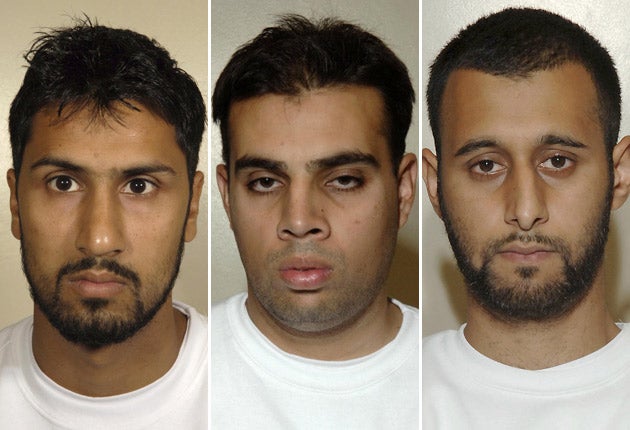The trio guilty of plotting Britain's 9/11
Three British Muslims convicted of plan to blow up transatlantic airliners that could have been deadlier than the twin tower attacks

Three British Muslims were convicted yesterday of plotting to commit "mass murder on an unimaginable scale" by blowing up transatlantic airliners in an attempt to kill thousands of people in the air and on the ground.
The terror cell, operating under guidance from jihadist overseers in Pakistan and inspired by al-Qa'ida, planned to simultaneously detonate liquid bombs disguised in soft drink bottles on board at least seven flights from Heathrow to North American cities, a court heard.
Last night, senior Scotland Yard detectives told The Independent that, if the plot had been successful, the death toll could easily have exceeded the 2,752 people killed in the 9/11 attacks on the US in 2001.
The conspiracy was thwarted in August 2006 by the biggest counter-terror operation ever mounted in the UK. It brought chaos to Heathrow and led to new, worldwide restrictions on passengers' hand luggage, with a ban on the carrying of liquids on to aircraft.
The convictions will offer some relief to ministers who were criticised for introducing the luggage restrictions, and to prosecutors who asked for a retrial after a jury failed to reach verdicts on key charges last year. The combined cost of the police investigation, Operation Overt, and the two trials is estimated at £135m.
Abdulla Ahmed Ali, 28, a computer engineering graduate, of Walthamstow, north-east London, led the plot. He was arrested with details of flights all from Britain to San Francisco, Toronto, Montreal, Washington, New York and Chicago within a two-hour period. Such was his commitment to his cause that he discussed taking his infant son on the suicide mission, jurors at Woolwich Crown Court were told.
The cell's "quartermaster", Assad Sarwar, 29, of High Wycombe, Buckinghamshire, and Tanvir Hussain, 28, from Leyton, east London, who helped to build the bombs, were convicted with Ali of conspiracy to murder by causing explosions on board aircraft. Over eight months, they painstakingly gathered equipment to make liquid explosives and liaised with contacts in Pakistan as they sought to recruit an inner circle of British Islamic extremists to carry out the attack.
At their earlier trial last year, the three men were convicted of conspiring to murder using the devices, but the jury could not decide whether their plan extended to attacking airliners. Yesterday, after six months of evidence and 54 hours of deliberation, the second jury decided that the scheme had indeed existed.
Deputy Assistant Commissioner John McDowall, head of Scotland Yard's Counter-Terrorism Command, said: "If these terrorists had been successful, many people would have lost their lives. Many more would have died if they had chosen to detonate their bombs over land. They intended to cause carnage and bring terror into the lives of people around the globe."
In one of six suicide videos recorded by the plotters, Ali cited Osama bin Laden as his inspiration and warned of "a rain of body parts on the streets of America".
The jury rejected Ali, Sarwar and Hussain's defence that the plot was an elaborate publicity stunt designed to attack British foreign policy. They will be sentenced on Monday.
Three other defendants – Ibrahim Savant, 28, Arafat Khan, 28, and 25-year-old Waheed Zaman were cleared and the jury failed to reach verdicts on charges of conspiracy to murder.
One man, Umar Islam, 31, was convicted of conspiracy to murder but the jury failed to decide whether he was involved with the airliner plot.
Donald Stewart-Whyte, 23, of High Wycombe, was acquitted of conspiracy to murder on aircraft and conspiracy to murder.
Britain's 9/11
It was a plot designed to cause thousands of deaths on a series of transatlantic flights taking off from Heathrow. Armed with liquid bombs, the conspirators would board planes bound for America and then detonate their explosives mid-air. But all the while they were being watched by police and yesterday three men were found guilty of an attempt to commit 'mass murder on an unimaginable scale'.
1: THE WAREHOUSE
The explosives to be used in the devices were found in or near Assad Sarwar's home inWalton Drive, High Wycombe. A total of 40 litres of hydrogen peroxide was found with some being stashed in a suitcase that was eventually discovered in woodland near the house. Police found the explosives after a search of the woods, which added £7.8m to the cost of the operation.
2: THE BOMB FACTORY
The group bought a house in Walthamstow in July 2006, to use as a bomb factory. They paid £138,000 for 386a Forest Road. A day after purchasing the house, Abdulla Ahmed Ali enquired about buying intruder detection cameras. But unbeknown to him and his cohorts, they were being bugged. Undercover surveillance officers planted a listening device which recorded the men discussing the plot.
3: THE TARGET
Heathrow was the take-off point for the plot. The men planned to board flights from the airport to popular tourist destinations and detonate their devices in mid-air. Ali had looked up the BAA Heathrow website and the men had discussed the most popular flight destinations for British tourists with Washington, Chicago, Miami and California being mentioned.
4: THE BOMBS
The bombs were to consist of two segments: the main hydrogen peroxide (HP) charge contained inside plastic Lucozade or Oasis bottles, and the Hexamethylene triperoxide diamine (HMTD) detonator in battery casings. They planned to use the powdered soft drink Tang as a ‘fuel’ to release the explosive properties of the HP, and drops of food colouring to make the liquid bombs resemble ordinary soft drinks.
Meanwhile, the HMTD — a crystalline substance made using everyday household chemicals — would be packed inside the hollowed-out batteries, alongside miniature lightbulbs with the glass filed away.
The device would be set off by strapping the battery detonator to the bottle bomb and running a current through the lightbulb filament, using a disposable camera.